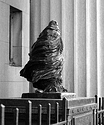rbultman
Member
The following concept is a huge simplification that leaves out many variables that affect real world results, but the basic principle is true.
...
(This is one of the reasons that many B&W shooters are passionate about minimizing exposure)
...
I don't understand this. I thought many B&W shooters typically rate their film at 1/2 box speed. This translates into more exposure than is called for by box speed. Can you clarify please?
Sent from my Nexus 5 using Tapatalk





 Someone needs to make the movie.... probably wouldn't do too well at the box office though.
Someone needs to make the movie.... probably wouldn't do too well at the box office though.

